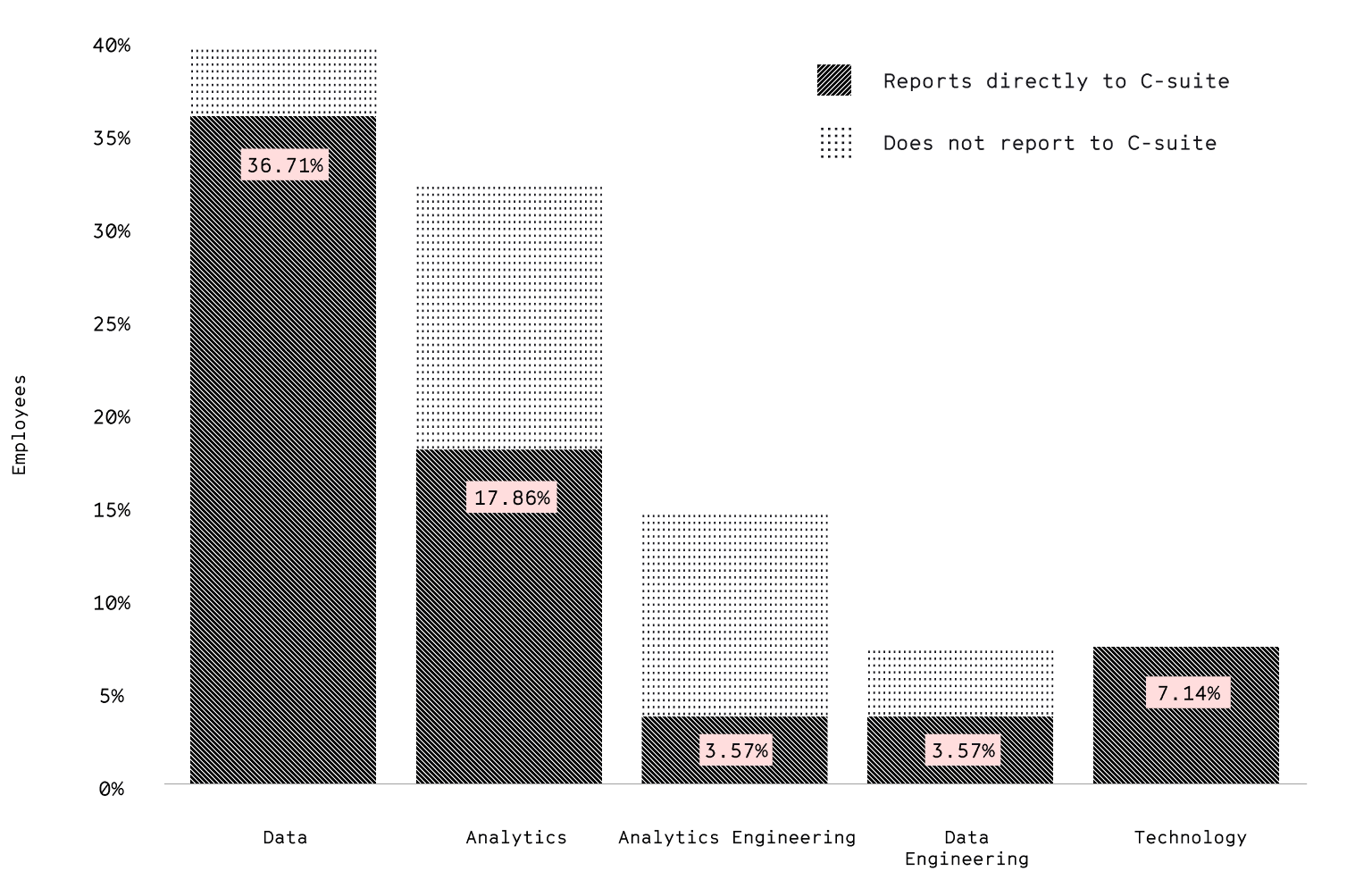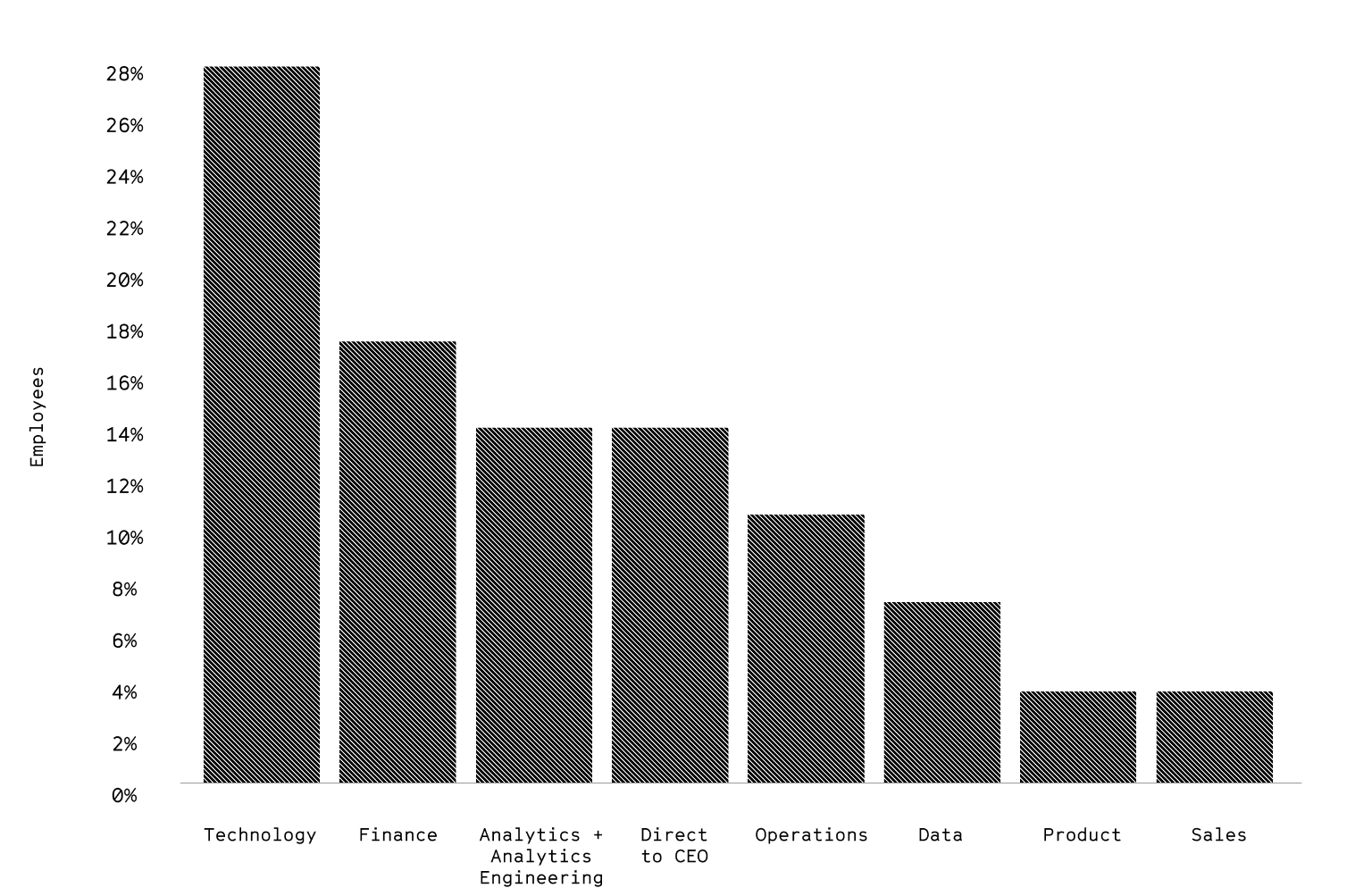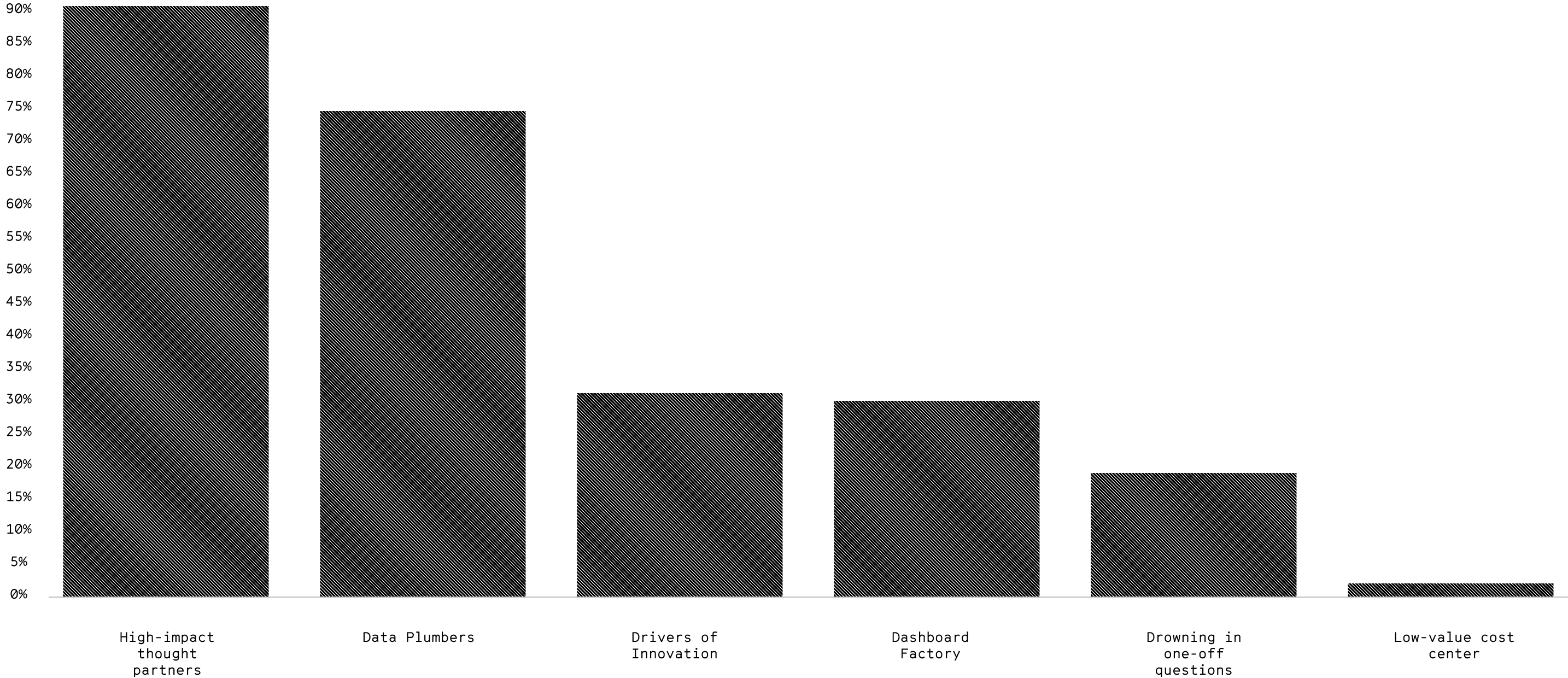From building stacks to building impact
AI is everywhere... except in production
Let’s take a moment to appreciate just how far data has come. Twenty years ago, “self-serve analytics” meant someone emailed you a spreadsheet (and sometimes it still does ;) ). Since then, we’ve leapt into BI tools, the cloud and modern data stack, machine learning and predictive techniques, and now we’re co-piloting our analytics with generative AI. Kinda wild, right?!
And yet… for all the excitement (and vendor hype) around AI, the impact so far has been pretty limited.
We sent this survey to over 2,000 data leaders — from early-stage startups to global enterprises — and while most of them said they’re excited about AI, most leaders told us they’re still underwhelmed by the tools available, and few have seen AI drive meaningful change in their workflows just yet.

Meanwhile, data teams are still growing, and self-serve remains a goal, not a reality. Leaders agree that AI could help, but no one we spoke with has seen it working well at scale. IC business analysts have transformed into critical data teams, and in 2025 they’re being asked to do more than just manage tools: they’re expected to drive real business impact. This report explores what’s standing in the way and where forward-thinking teams are focusing their energy next.
We’ll explore four main takeaways
Leaders are excited about AI, but very few have put anything into place.
77%
of leaders say they are excited about the possibilities of AI in data, but only 3% make it a top priority.
Self-serve isn’t working, and leaders are seeking new ways to solve it.
70%
describe self-serve as a “worthy goal,” but many have hit roadblocks in making it a reality, and are considering changing tools.
Data teams are growing and tackling more diverse problems.
90%
of data teams are hiring and growing or staying steady.
Teams are bogged down by recurring tasks like data quality.
84%
say they spend most of their time thinking about data quality and reliability concerned about consistency, governance, and multiple toolsets.
Data leaders have mixed (but mostly positive) feelings about AI!
Answers to “on a scale of 1-5, how much time do you spend thinking about the following categories?”
5 - being "a main focus area for the team."
1 - being "barely think about it."
We asked our participants to rank several common data challenges in terms of importance on a scale of 1-5.

When asked about aspirations, data leaders brought up AI a lot
Only 3% said AI is “a main focus for me and my team” and only 35% rated it a 4 or 5 (out of 5) in terms of importance. While few data leaders identified AI as a top area of current focus, AI is something that came up frequently when they talked about aspirations, as you can see in the quotes to the right.
Incorporate more AI & automation into the work to reserve human hours for high leverage, difficult analyses.
Head of Analytics (400 person org)
Understand near-term impact of GenAI on our business and way of working
Sr. Director, Data Science & Analytics (7,000 person org)
Stability, and speeding up workflows through AI
Manager, Analytics Engineering (8,000 person company)
Getting value from AI on data is about building the infrastructure to support it
Data teams have grown increasingly diverse. Whereas data was once thought of as a reporting function, new technologies have forced data teams to expand their capabilities and their impact, with roles like analytics engineering, ML engineers, and now AI experts.
Here’s a view of how data teams identify. The diversity is apparent.
Of the data leaders who responded to our study, over 70% report directly to a member of the C-suite
Data teams have grown increasingly diverse. Whereas data was once thought of as a reporting function, new technologies have forced data teams to expand their capabilities and their impact, with roles like analytics engineering, ML engineers, and now AI experts.
Of the data leaders who responded to our study, over 70% report directly to a member of the C-suite
Data teams also increasingly aspire to align with business OKRs. Many of the participants in our study described a centralized function with specialization based on the business unit they support (product analytics, marketing analytics, etc, while still reporting into a central data function). They described themselves as strategic influencers with goals to align closely to business initiatives.
While aware of the promise and potential of AI to transform their processes, data leaders are balancing a complex list of tasks, KPIs, and specialties. They’ve grown used to hiring experts to expand their capabilities into new technical areas. Adopting AI means building the cycles to implement it successfully without dropping the ball on other tasks that have grown mission critical to their organizations.
[We] align ourselves to business verticals with embedded elements. [We] continue to work on high impact initiatives, simplify data models and keep data platform infra manageable by small team
Head of Data (100 person org)
[We are] strategic advisors that enable the organization to make better decisions with data. We've rolled out new tools to improve on platform experimentation and marketing measurement
Sr Director, Analytics & Data Science (200 person org)
We work closely with the executive team to set company goals for product, marketing, and operations and create accountability towards those goals.
Director of Product and Customer Analytics, report to the VP of Data (700 person org)
The good news: data teams are still growing. 90% of our respondents are either growing their teams or keeping their staffing level. The hand-wringing over AI eliminating analyst jobs has not come to bear (yet).
How would you characterize the growth of your team in the last 2 years?
Self-service is not working, creating a new opportunity for AI on data
Where data teams are seeking key opportunity areas or places to focus when adding AI to their strategies, they are finding an applicable area in their traditional self-service analytics solutions.



Self-serve described as a “worthy goal” by 70% of respondents
We asked data leaders about their opinions of self-serve. Is it a worthy goal, or is it an elusive myth? While 70% agreed it was worth investing in, decades of wasted investment in failed and ambiguous solutions has led to consternation about how to define the essential concept of self-serve.
Part of our job is to help our business partners understand what they can answer on their own and when they should work with the analytics team.
Sr Director of Strategic Analytics + Data Science, 200 person organization
There's always nuance that's hard to control for when talking about self-serve. Both in the data reliability sense but also in the data literacy sense (e.g., selection, causality, etc). And when it comes to data and informed decision making, the nuance is usually where you find growth.
Sr Director of Analytics and Product Strategy, 80 person organization

Ultimately, customers aren’t happy with the status quo of BI tools
Am I happy? No. They haven't built anything new in a while.
Our environment is a huge mess, we are cleaning it up this year.
It is a love/hate relationship. I am considering making a change in the next year.
We’re unhappy, internal users complain about all all the time.
I hate it, it's a waste of time.
How do they solve the problem?
AI is emerging as a new, promising opportunity area that can help improve self-serve efficiency in multiple ways.
Data teams are anticipating AI-driven transformation, growing their teams to support it, and have identified self-serve as a key opportunity area. But there are other tasks threatening to take the teams’ attention and prioritization away from innovative areas.
Huge investment in AI tools for analysts (to make them more efficient) and business users (to improve self service).
Director, Data & Analytics Strategy (8,000 person org)
I think the concept that AI can help accelerate the work of people with some basic data skills is uncontroversial in the same way that it helps you as a co-pilot when you're writing code.
Head of Data (1,000 person org)
Planning a change but would like to wait for the industry to absorb some of the new genAI capabilities before seriously scoping
Director of Product and Customer Analytics (700 person org)
How data leaders are thinking about self-serve
Redefine self-serve around its goals, not its artifacts - in our study, data leaders debated the definitions of self-serve, but they agreed on its core benefits.

With AI changing the paradigm for analytics, there’s an opportunity to rethink what it looks like. Questions like “what information really needs to be surfaced in a dashboard?” and “how can business stakeholders request new insights from the data team?” can be rethought from first-principles considering modern technology.
It is a spectrum. Sometimes it means they bookmarked it and remember how to find it, sometimes it means they can apply filters and double click.
Data & Analytics Manager (190 person organization)
You want business users to confidently self-serve on the easy stuff so analysts are focusing their time where they have unique comparative advantage.
Sr Director, Data & Analytics Strategy & Ops (8,000 person organization)
Data teams are still bogged down supporting data trust
As data leaders are shifting to support the company’s biggest initiatives and prepare for AI, it makes sense that data trust is the area where the majority of people are spending their time.
We’ve all been there — you share your perfectly crafted report with the business stakeholder and they say “I don’t think that’s right, where did this number come from? It’s not the same as what’s in my spreadsheet.”
Trust directly impacts key business priorities like self-service analytics adoption, AI model accuracy, and leadership's confidence in data-driven decisions. If they can’t trust their own data, why adopt new technology? It’ll just make the problem worse.
[We need to] develop our "data platform" foundations — currently a lot of our metrics and capabilities are individual product-specific, with a lot of "scrappy" 0 to 1 work that needs to be integrated together.
Director of Product & Customer Analytics (700 person org)
84% of data leaders rated data quality and reliability their highest area of focus
Answers to “which of these describes your data team?”While the data leaders in our study have confidence that they are helping their organizations, a high percentage of them refer to themselves as “Data Plumbers,” showing that a big part of the job is still ensuring data availability and reliability.

With so many data leaders focused on this challenge, let's explore how they're working to solve it.
Some organizations are investing in new technology to help solve the problem. 50% of those surveyed said they have made an investment in a semantic layer to help build some consistency and reliability around data. But some leaders expressed skepticism that this is actually helping.
The recent trend of BI products bundling in a proprietary semantic layer has done more harm than good. Of the customers who said “we have a semantic layer as part of our BI tool,” 57% are considering a change in tools this year.
In essence, an investment in data quality should be an investment in AI. Improved data trust should help improve the trust in AI-generated insights. But when data quality is built around adoption of a point solution, it only increases sprawl.
I guess we technically have two [semantic layers] (dbt and LookML since we use Looker -- and maybe a third emerging in Hightouch?). We try to keep most of our modeling in dbt and make the other layers thin/dumb.
VP of Data (600 person org)

How data leaders are thinking about data quality
Look for opportunities to unify tooling - it will benefit your bottom line, make it easier to centralize on a single trust layer for data, and enhance your AI investments.
Data teams are anticipating AI-driven transformation, growing their teams to support it, and have identified self-serve as a key opportunity area. But there are other tasks threatening to take the teams’ attention and prioritization away from innovative areas.
Unify legacy systems & reports. Improve data culture. Begin to build innovative data products.
VP of Data (14,000 person org)
Develop our "data platform" foundations — currently a lot of our metrics and capabilities are individual product-specific, with a lot of "scrappy" 0 to 1 work that needs to be integrated together.
Director of Product & Customer Analytics (700 person org)
Thinking of AI as an accelerator, not a net new function
It might be that the role of AI in the data stack is still ambiguous. Or that data quality isn’t where it needs to be to power reliable models. Or maybe there’s simply no clear playbook yet for where AI fits in a modern data org. All of that makes sense — this is new territory.
Data teams for whom AI is a main focus

As we looked at the responses from data leaders in our study, we found a theme that inspired us: Data leaders are thinking of AI as a way to provide more focus. This results in several tactical recommendations for how to start reaping the benefits from AI on data today.
Our survey participants have identified 3 major roadblocks to adopting the most modern technologies for data and leveraging the best of AI.
So what can you do? How can you move faster and avoid an AI-centric innovator leaving you in the dust?
Data leaders have a few suggestions.
AI can accelerate data trust projects
We've started using AI meaningfully to make decisions by using an LLM to help with a first-pass of documenting all of our data models (and then we have a human in the loop review it).
Head of Data (1,000 person org)
AI-driven self serve can create data team capacity for more strategic data insights
There will always be more questions, because as you make it easier to answer questions, the cost of asking questions goes down. The remaining ones that make it to the data team will be the more complex ones.
Head of Analytics Engineering and Data Science (1100 person org)
AI can't replace human influence, but can complement it
Setting up stakeholders with data is a conversation about what problems you’re having in the business, what’s keeping them up at night, and the processes that are involved in generating this data. That's the hard work of being a good data person. And the AI is not going to figure that one out
Head of Data (65 person org)
Over the past few years, data teams have been busy modernizing their stacks, investing in tools, and growing their organizations. But success won’t just come from better technology and bigger teams, it will come from impact.
While data teams are expanding, they’re also grappling with persistent challenges around data quality, self-serve, and how to navigate AI technologies. The teams that thrive in 2025 and beyond will be the ones who align closely to business outcomes, deepen trust with stakeholders, and use new technology as an accelerator.